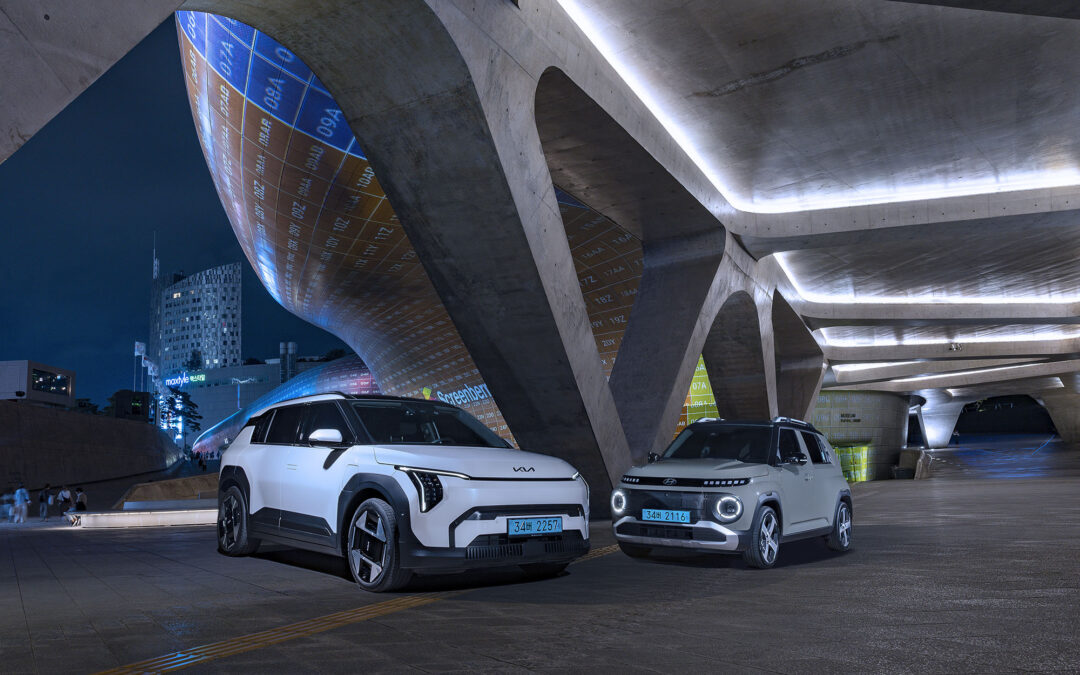
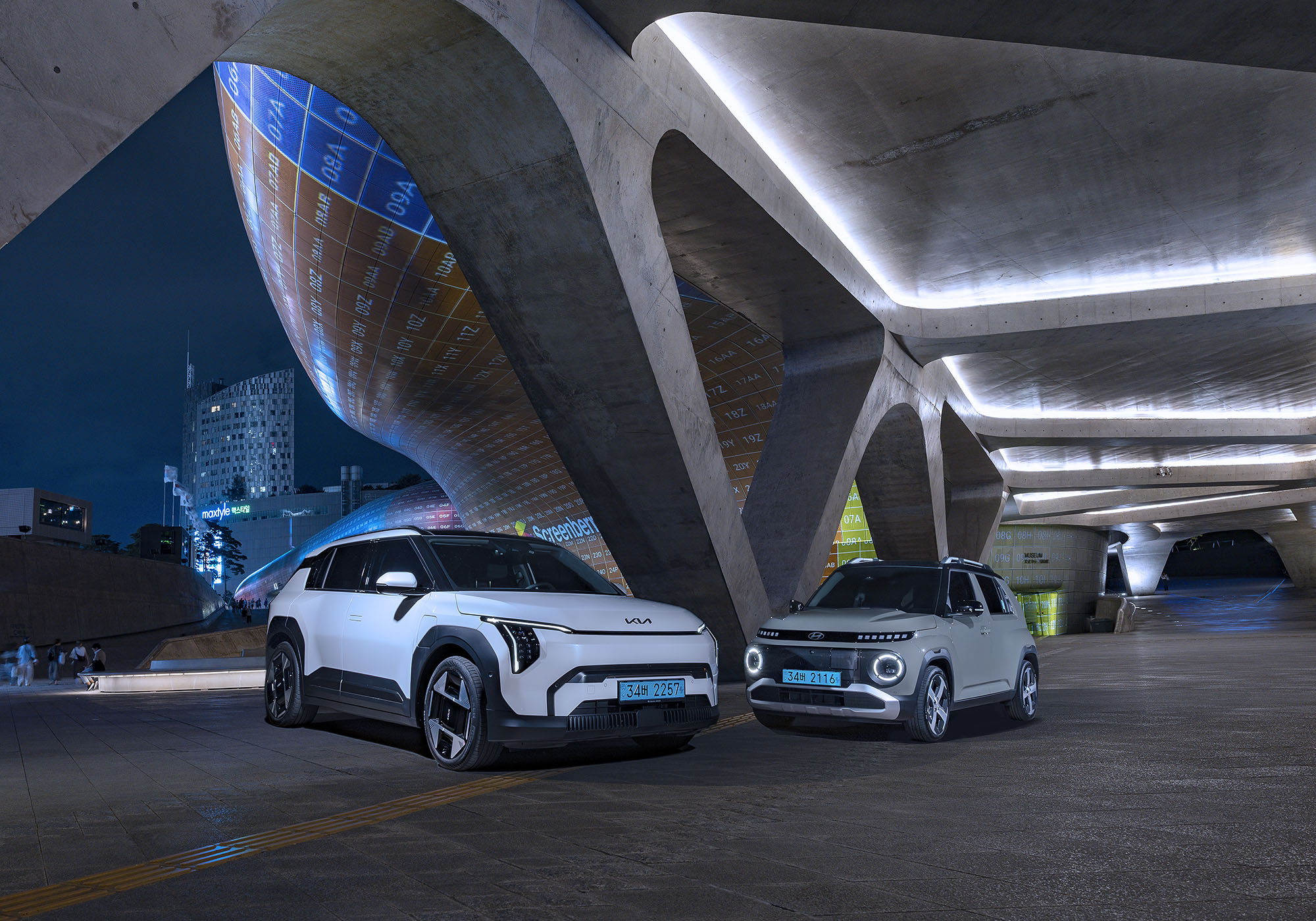
FUNK SEOUL BROTHERS
We visit Seoul to drive the new small electric Kia and Hyundai, and find out how South Korea has tapped the zeitgeist so well
It’s well after midnight. Seoul is a sprawling and sweating 8000-square-mile sauna. Despite the energy-sapping combination of 35ºC heat and 95 per cent humidity, the Gangnam district is absolutely heaving. Youngsters pour in and out of brightly illuminated cafes, bars, photobooth shops and barbecue houses, their hands full of phones, cigarettes and mini fans. They swarm across Gangnam’s tight grid of roads and alleys with scant regard for the cars, scooters and e-bikes that deftly weave through and around them. The shimmering lights, the pulsing K-pop soundtrack, the aromas of grilled steak, perfume, beer and smoke, the gritty back-of-your-throat taste of hot urban concrete – welcome to the world’s most dynamic city.
I slip silently past Gangnam’s saturated late-night revellers, relaxing in the icy air pouring out of the Kia EV3’s air vents and the wonderfully comfortable chilled seat. Heading north through the Korean capital’s 24/7 rush-hour traffic, I cross the Han River and then peel west for Hyundai’s design centre in Goyang to collect the electric-only Inster, Hyundai’s new urban car. Two very different cars from two auto giants that are on fire. They’re chasing different customers, but they both favour a fusion of class-leading battery technology and jaw-on-the-floor design.
They’re buoyed along by hallyu, Korea’s cultural wave spearheaded by musical phenomena like BTS, NewJeans and Blackpink, the television sensations Squid Game and All of Us Are Dead, and Oscar-winners Parasite and Minari. And both marques are rocketing into the future fuelled by a confidence that comes from stealing up on their American, European and Japanese rivals, catching them comatose at the wheel.

EVERYTHING KIA KNOWS ABOUT MAKING CARS IN ONE NEAT PACKAGE
This year Kia celebrates its 80th anniversary; Hyundai started life three years later but got into cars in 1967, seven years before Kia. Hyundai, now the bigger brand, has owned Kia since 2015.
In a very long journey over a short period of time, Kia has evolved from Kyungsung Precision Industry producing bicycles, to Kia Corporation producing the world’s most advanced and desirable electric vehicles. And this new EV3 will be a keystone model in this continued success. The EV6 and EV9 boldly signalled Kia’s design- and technology-led approach to the EV sector, but they’re effectively high-value halo models. Against a backdrop of quickly cooling EV ardour, not helped by high prices, it’s this smaller and more affordable EV3 that’s tasked with racking up the big global sales.
Tough gig, but it steps onto the stage with everything going for it – an attractive £32,995 start price, family-friendly functionality wrapped in dramatically futuristic styling, and class-leading battery and charging tech. That pricing takes the fight straight to VW (the smaller-batteried Air undercuts VW’s £35,700 entry-level ID. 3 Pro Essential), Volvo (the base EX30 Core model starts at £32,850), Cupra (you’ll need £35,495 for the Born V1) and Jeep (£34,999 for the Avenger Longitude). Hear that? That’s the sound of the EV3’s competition weeping over their 2025 sales forecasts.
When deliveries start at the end of 2024, buyers will have the choice of three trim levels (Air, GT-Line and GT-Line S) and two battery packs (58.3kWh Standard Range and 81.4kWh Long Range) for respective WLTP ranges of 267 and 372 miles. Both versions power a single motor that drives the front wheels and is good for 201bhp and 209lb ft of torque. Vehicle-to-load and vehicle-to-grid functionality is standard, as is 400-volt architecture – down from the 800 volts on the EV6 and EV9 to cap costs – for 102kW and 128kW maximum charge rates. Irrespective of battery choice, that’s about 31 minutes for a 10-80 per cent top-up.
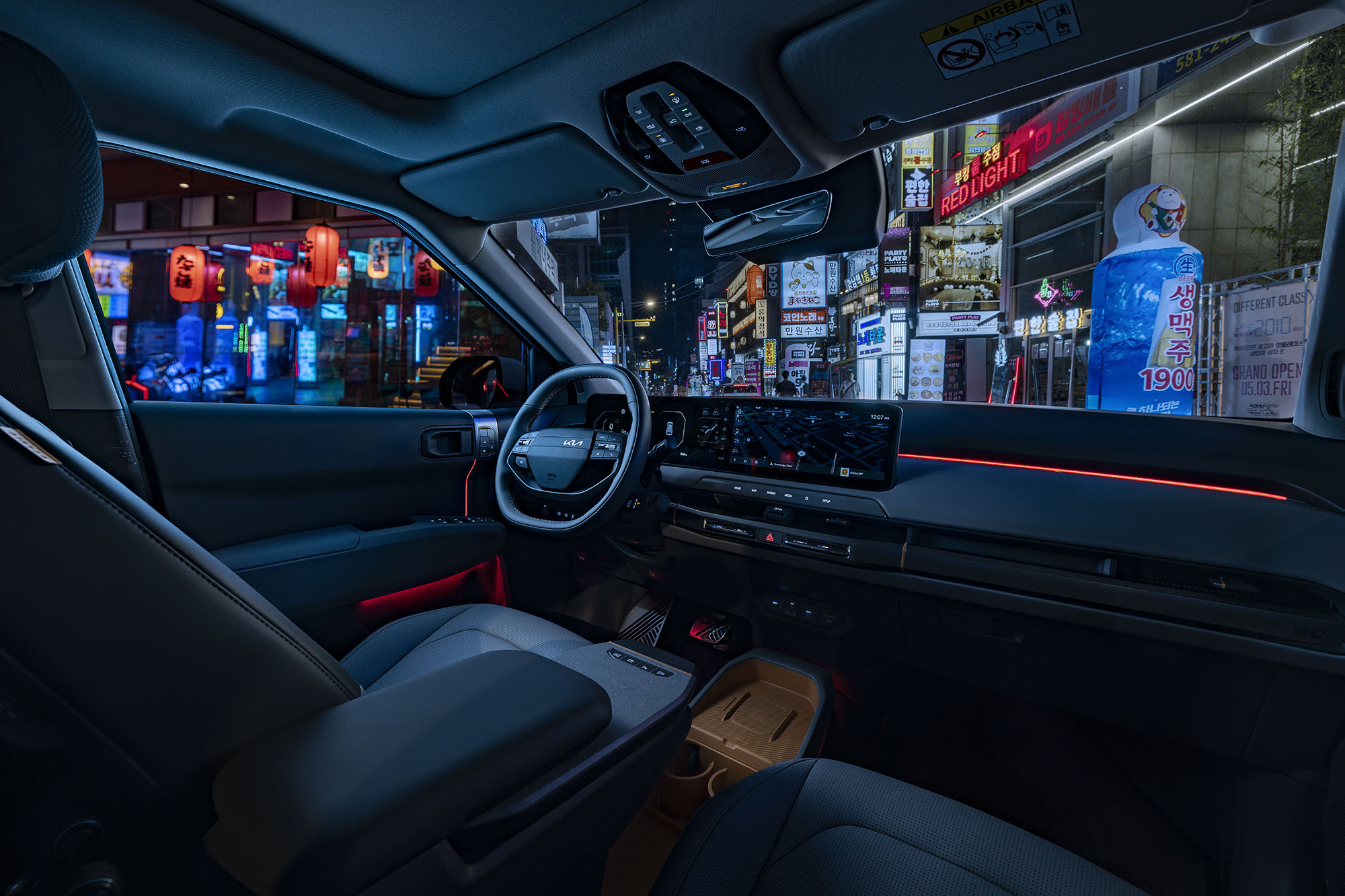
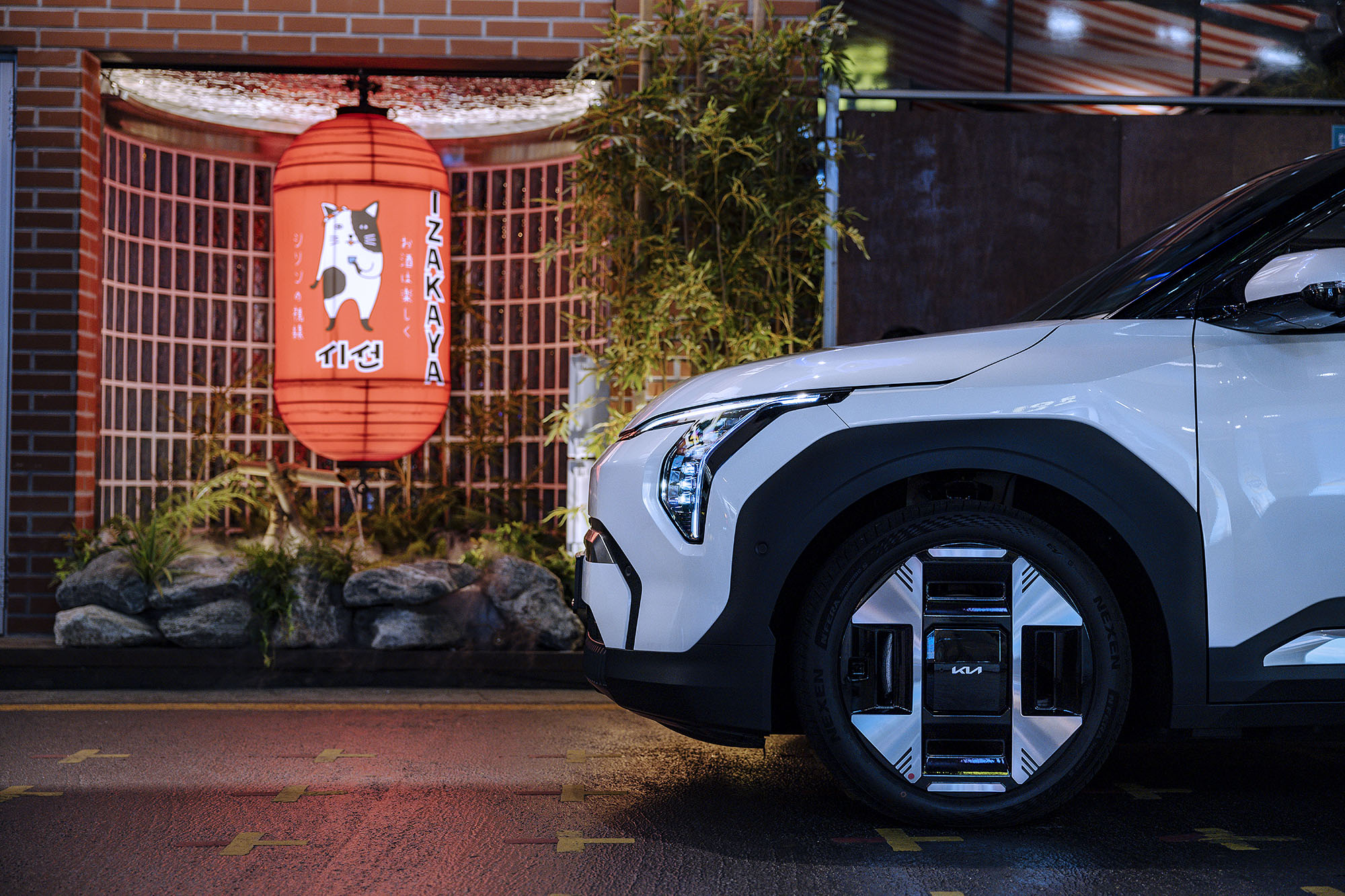
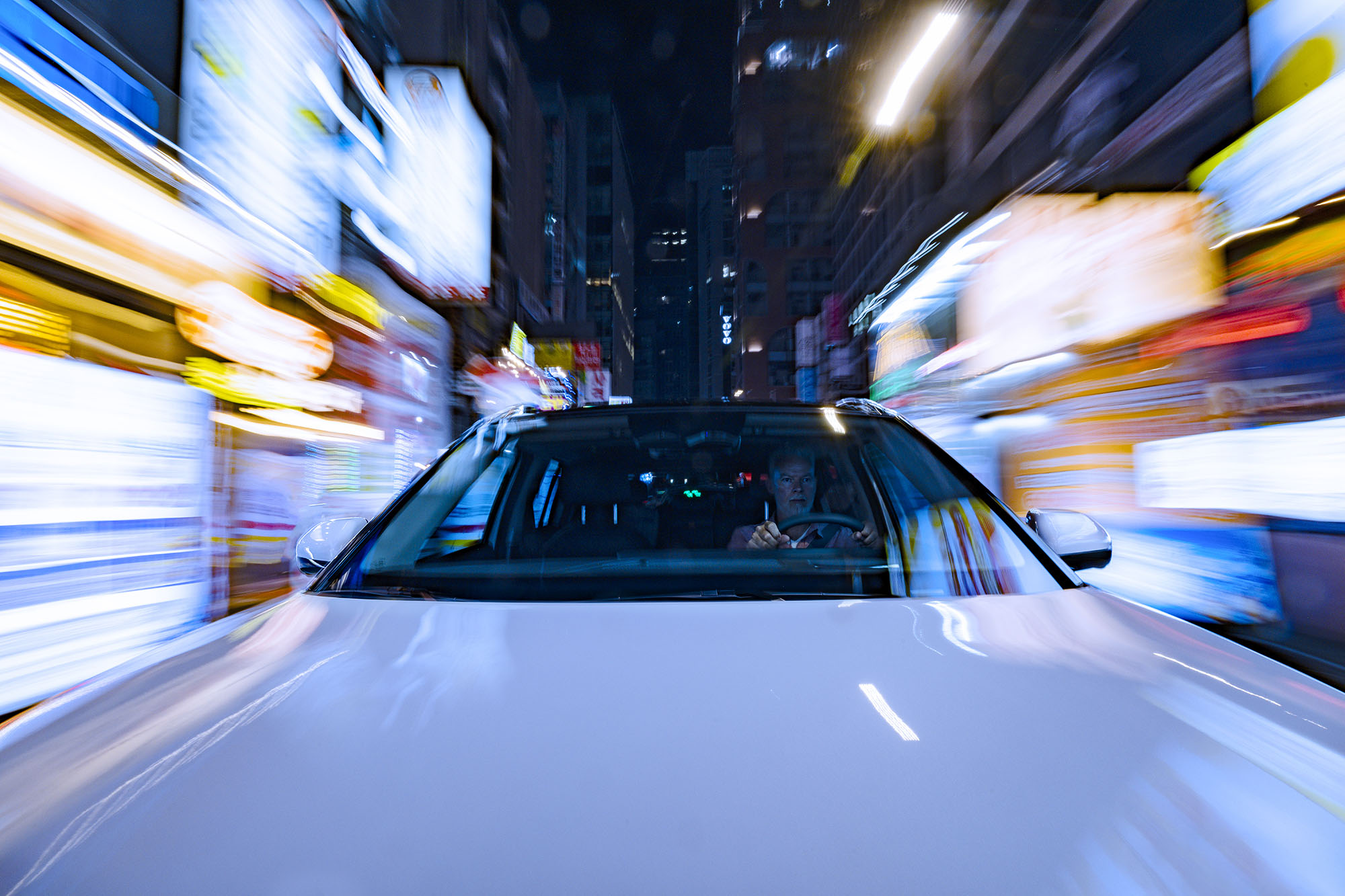
IT’S NOT JUST ABOUT THE NUMBERS
The more I look at the EV3, the more I‘m drawn in by its design. Squat four-square proportions, crisply creased sheet metal, dichromatic paint palette and an overall lack of adornment combine to imbue it with a sleek and ultra-modern style. Its collection of disparate shapes, angles and lines shouldn’t work but it does, and how. Illuminated by Gangnam’s nocturnal light shows it looks compellingly fresh and distinctive.
Its cabin game is strong, too. First take is the spaciousness. The combination of front-wheel drive, a first for Kia’s dedicated E-GMP Electric Global Modular Platform, long 2680mm wheelbase (the same as the Sportage), flat rear floor and slimline dashboard delivers almost decadent levels of room in all key areas. And there’s a massive 460-litre boot that expands to 1250 litres if you flip forward the 60:40-split rear bench, plus a handy frunk to swallow charging cables.
There’s a relaxing Scandi-like vibe onboard that perfectly complements the smooth and sophisticated drivetrain. Coarse-weave fabrics, matt flat plastics and brushed metal finishes all successfully work together to create an atmosphere of understated tactile luxury. Guilt-free, too. The cabin uses no leather, there’s no chrome inside or out, and each EV3 uses 28.5kg of recycled plastics, the origins of which can be found by using the little QR code found on the dashboard. Cute. The tech hardware is lifted straight from the EV9 – no complaints here – and safety, infotainment and connectivity equipment levels are very high. A pity, then, that for UK buyers heat pumps are a £900 option on the top GT-Line S model.
The EV3 is a calm and cultured sanctuary from the bedlam of Seoul’s traffic. It rides with a relaxed and easygoing gait, comfortably cushioning occupants from intrusions even when tackling craggier blacktop. It’s likely the spring and damper rates will be recalibrated for European-bound models, so I hope this car’s plump and softly-sprung composure isn’t lost in translation. At 2.75 turns lock-to-lock the feel-free but direct steering is quick enough to make short work of gap-chasing, car parks and the vaguely illegal-feeling U-turns that are allowed at major junctions. The brakes are onside, too, with plenty of immediate bite. That confidence-inspiring response grows when you lean harder on them, slowing up the 1885kg hatchback with ease.
Good job – the EV3 is positioned as a family hatch, but Standard Range models will sprint silently to 62mph in 7.4 seconds, with the heavier Long Range models just a few tenths behind. Quick enough to have the onboard speed warning system working overtime. There’s a generous helping of acceleration whenever I squeeze the long-travel accelerator, making overtaking a breeze. Both versions are reined in at 106mph. The Kia is no dynamic rule-rewriter, but it doesn’t put a foot wrong either. Driven with zest it handles itself with a pleasing, if unexpected, neutrality with all that low-down weight resulting in a flat cornering attitude and no tyre-scrabbling histrionics.
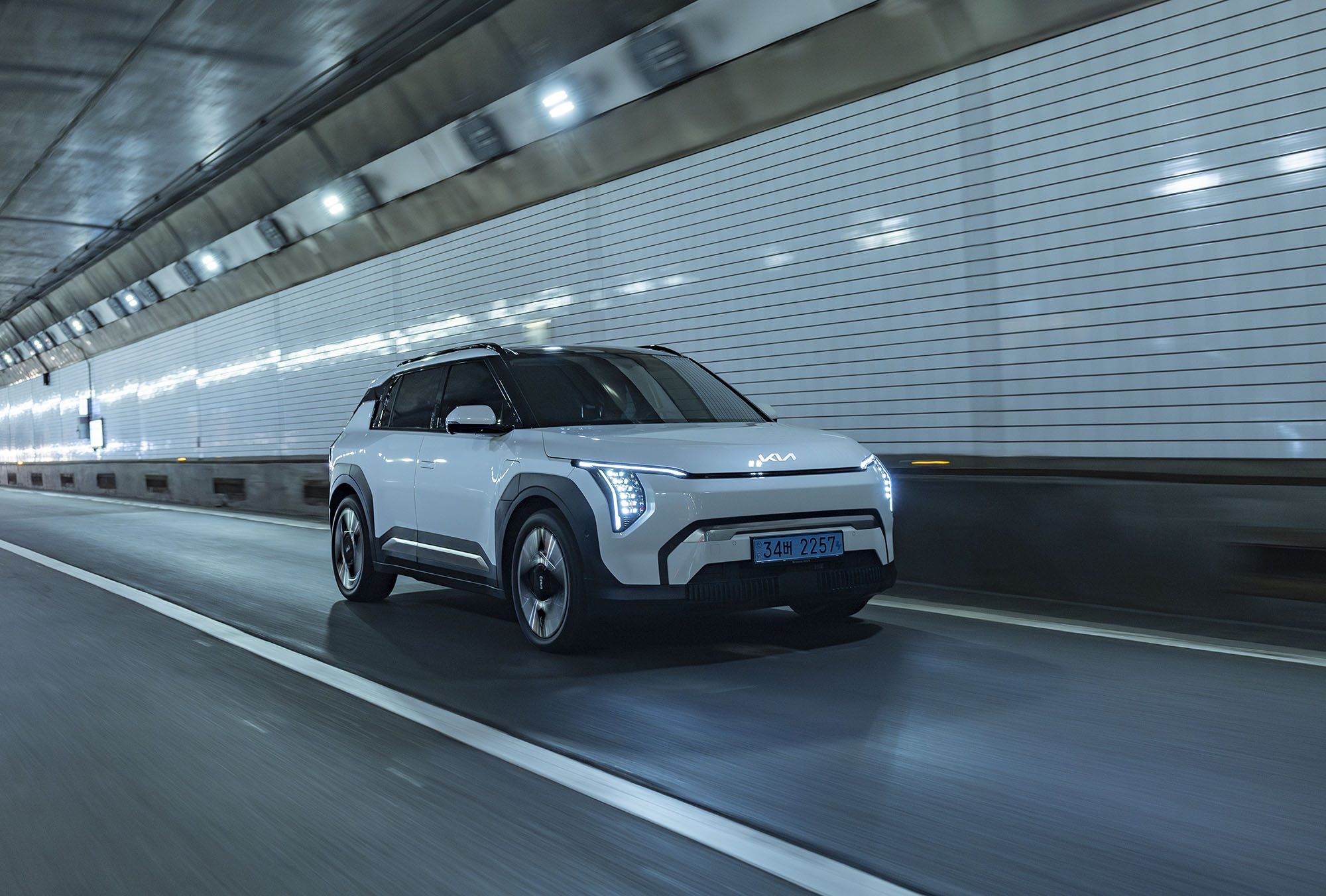
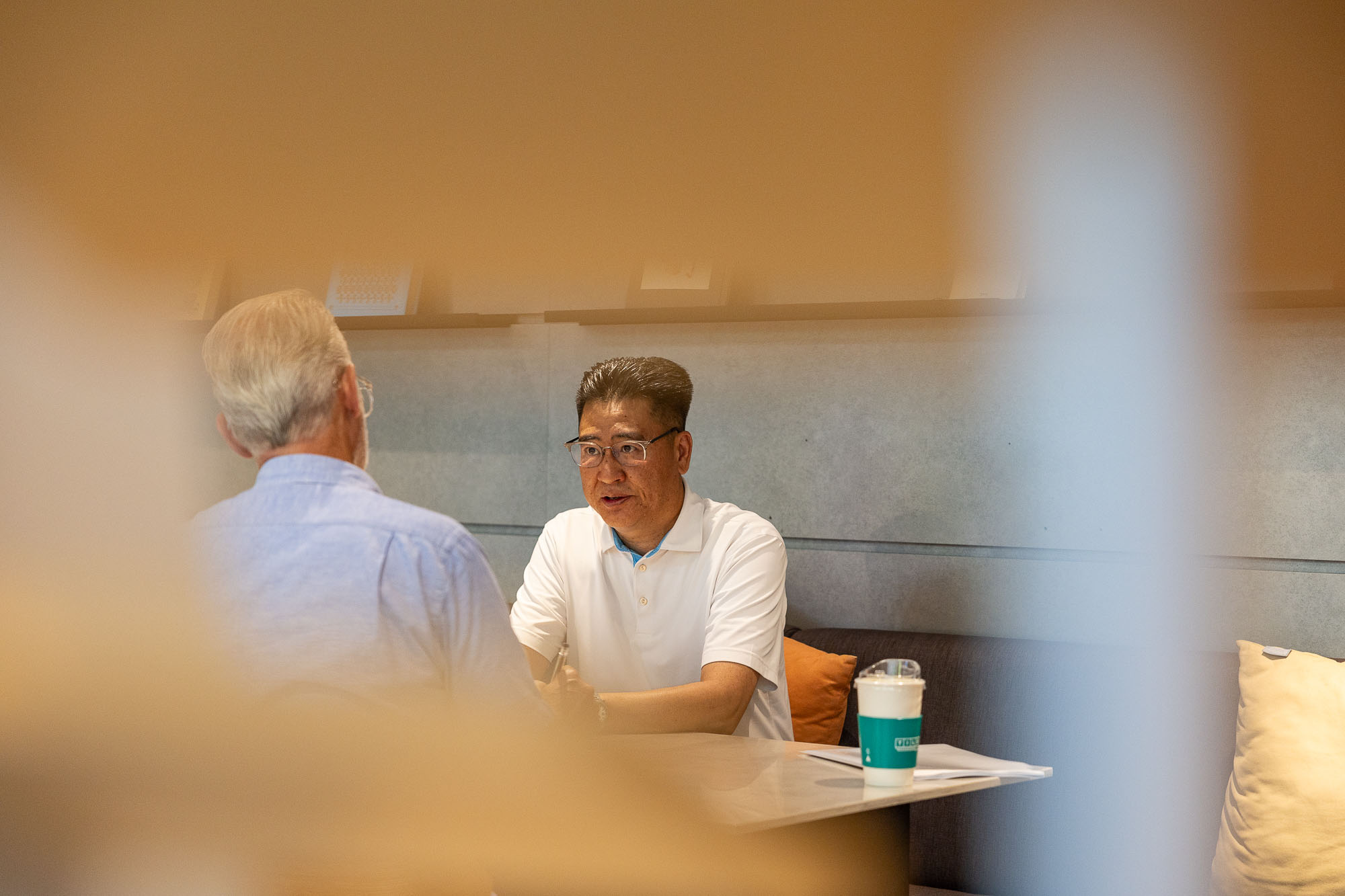
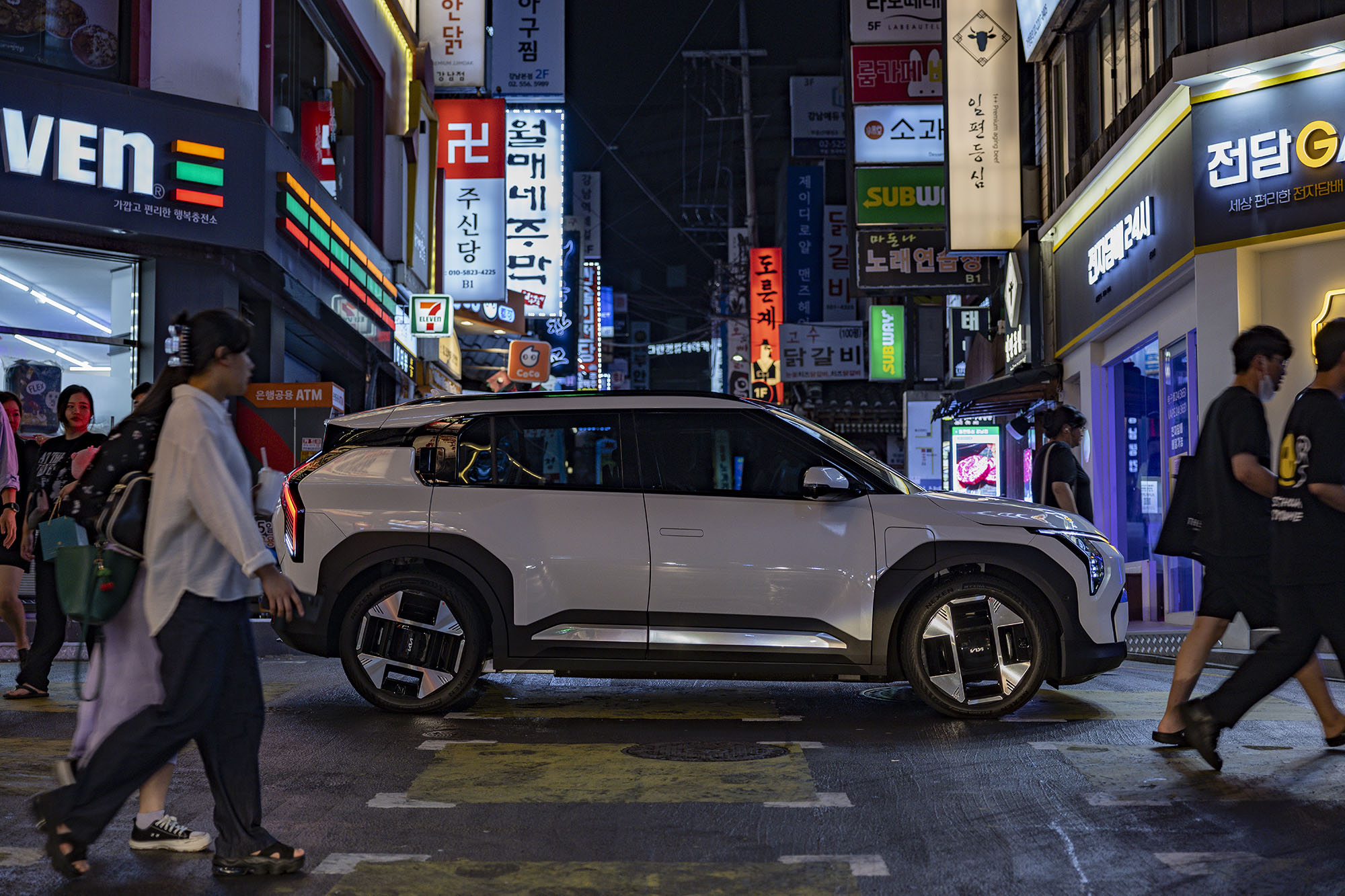
THE 80-YEAR-OLD START-UP
The EV3’s winning charm and confidence-inspiring confidence are vindication of the big claims made by Kia’s global head of brand, Michael Choo. Earlier that day he’d been telling me the secrets of the company’s success; turns out he was, if anything, being modest.
Born in San Francisco to Korean parents, Choo has lived in Korea since 1996. He worked at the Korea Development Institute think-tank and the Korea Trade-Investment Promotion Agency before moving to Kia in 2004.
Sipping iced coffee at Kia 360, the company’s plush brand experience centre in Gangnam, we discuss Korea, Kia and Hyundai, and their fast-track from decimation to dominance.
‘Korea’s post-war success is rooted in the shared Confucian values of the importance of the family, the appetite for education, the strength of the group over the individual, respect for elders, working hard and intense loyalty. When you combine these nationally understood values with the bold leadership qualities and foresight displayed by recent heads of Kia and Hyundai, you can begin to see how we have travelled so far so quickly. The continued focus on both soft and hard exports is now paying dividends – Korean music, cinema and food is now as popular and valued as our cars and electronics.’
And Kia and Hyundai – how have they continued to keep one step ahead when others have tripped up on technology or been too slow out the blocks?
‘The senior management think of Kia and Hyundai as start-ups and disruptors. Out with ties and suits, in with flexibility and a Gen Z laser-like focus on the future of mobility. Sure, that makes something incredibly difficult sound simple. But if you think like that for long enough, it becomes second nature.’
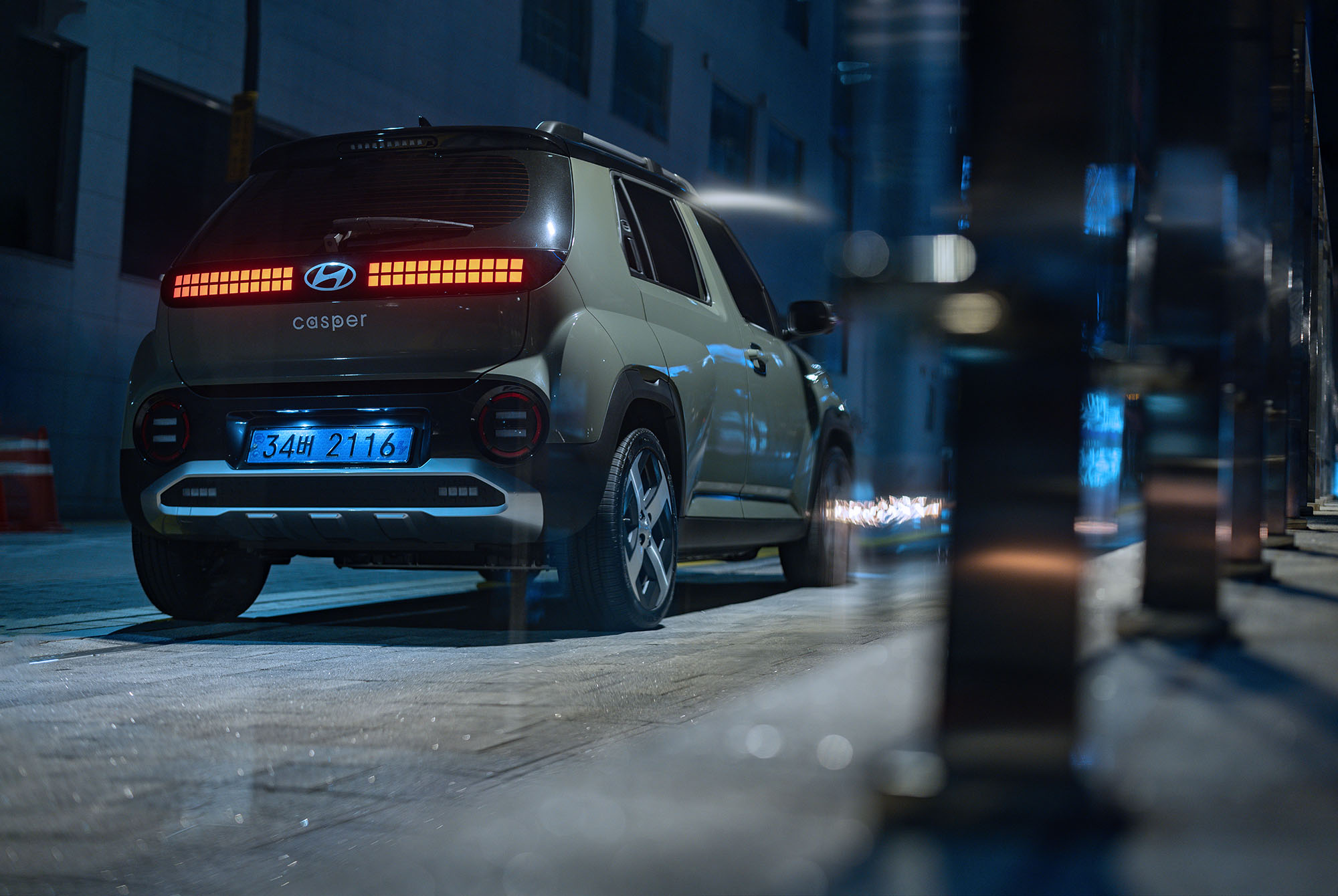
HYUNDAI’S NOT BEEN IDLE
I collect the new Hyundai Inster – badged Casper for the Korean domestic market – and double-back on myself for a rendezvous at Seoul’s Dongdaemun Design Plaza. The swirling silver Zaha Hadid-designed landmark houses shops, exhibitions spaces and restored elements of the capital’s city wall that dates back to the 14th century Joseon dynasty.
And that outlay doesn’t put you behind the wheel of some stripped-out and decontented base model, either. That gets you a 42kWh battery powering a single electric motor that dishes up 95bhp and 108lb ft for a 0-62mph dash in 11.7sec and an 87mph top speed. WLTP range comes in at a perfectly adequate 186 miles – it’s an urban car, remember, and the average UK car journey in just over eight miles. Expect standard equipment levels to be high.
There will also be a higher-spec model with a ‘Long Range’ 49kWh battery with a 229-mile WLTP range. Power climbs to 113bhp, the sprint time to 62mph drops to 10.6 seconds and top speed nudges 93mph. Both versions feature 400-volt recharging architecture with 73kW and 85kW charge rates depending on battery size. Both are fitted with a heat pump as standard – top work there, Hyundai – and are vehicle-to-load compatible.
At that price, its biggest rival will be Citroën’s rather excellent e-C3, with its well-judged combination of value, comfort, range and style. The impressive Dacia Spring is way cheaper than both, but you’ll only need a few minutes behind the wheel to realise why the Inster’s premium is money well spent. And the more expensive Fiat 500e? Pffft… try driving four-up and see which gives out sooner – your rear passengers or the Italian car’s 24kW battery.
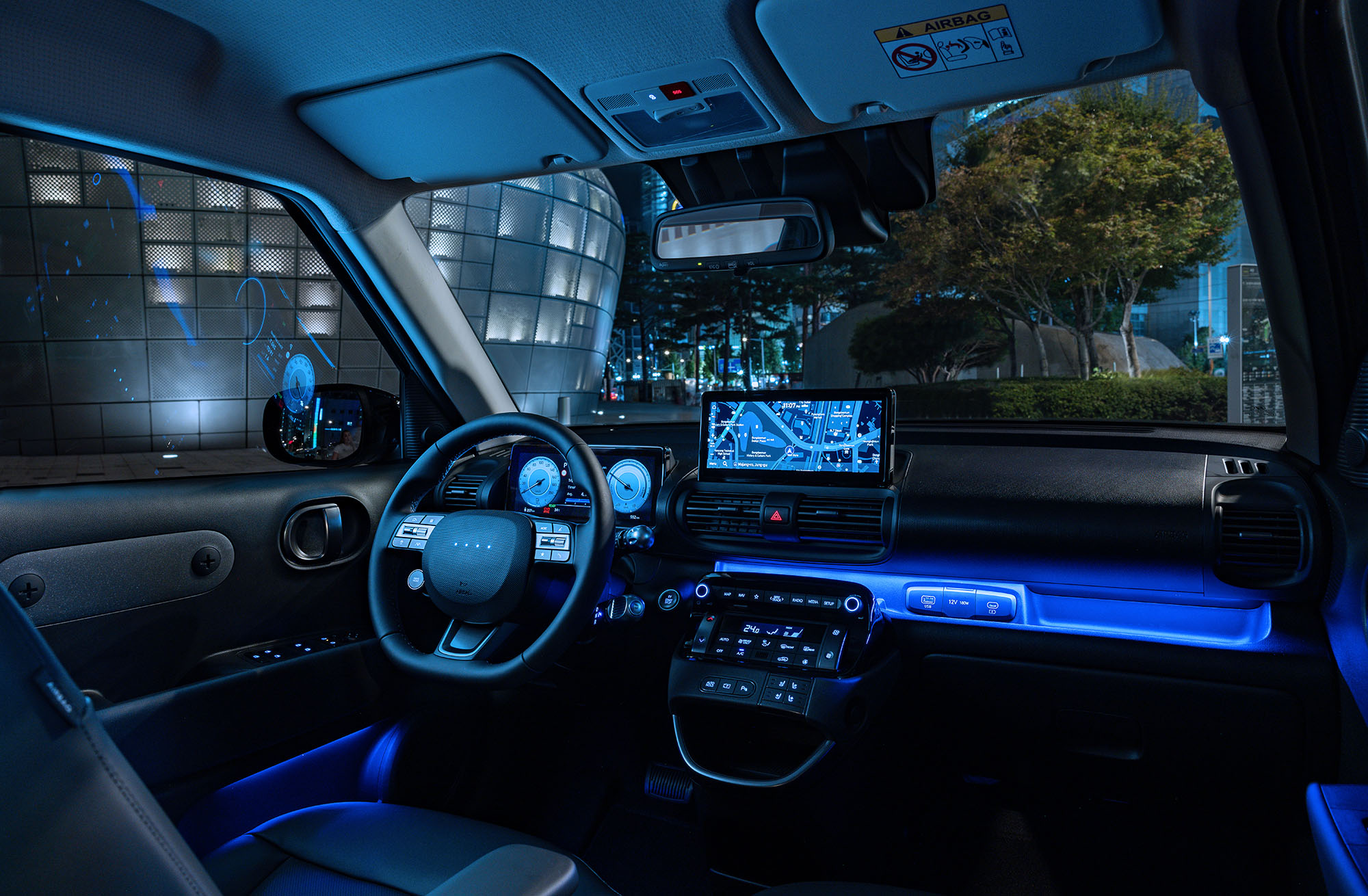
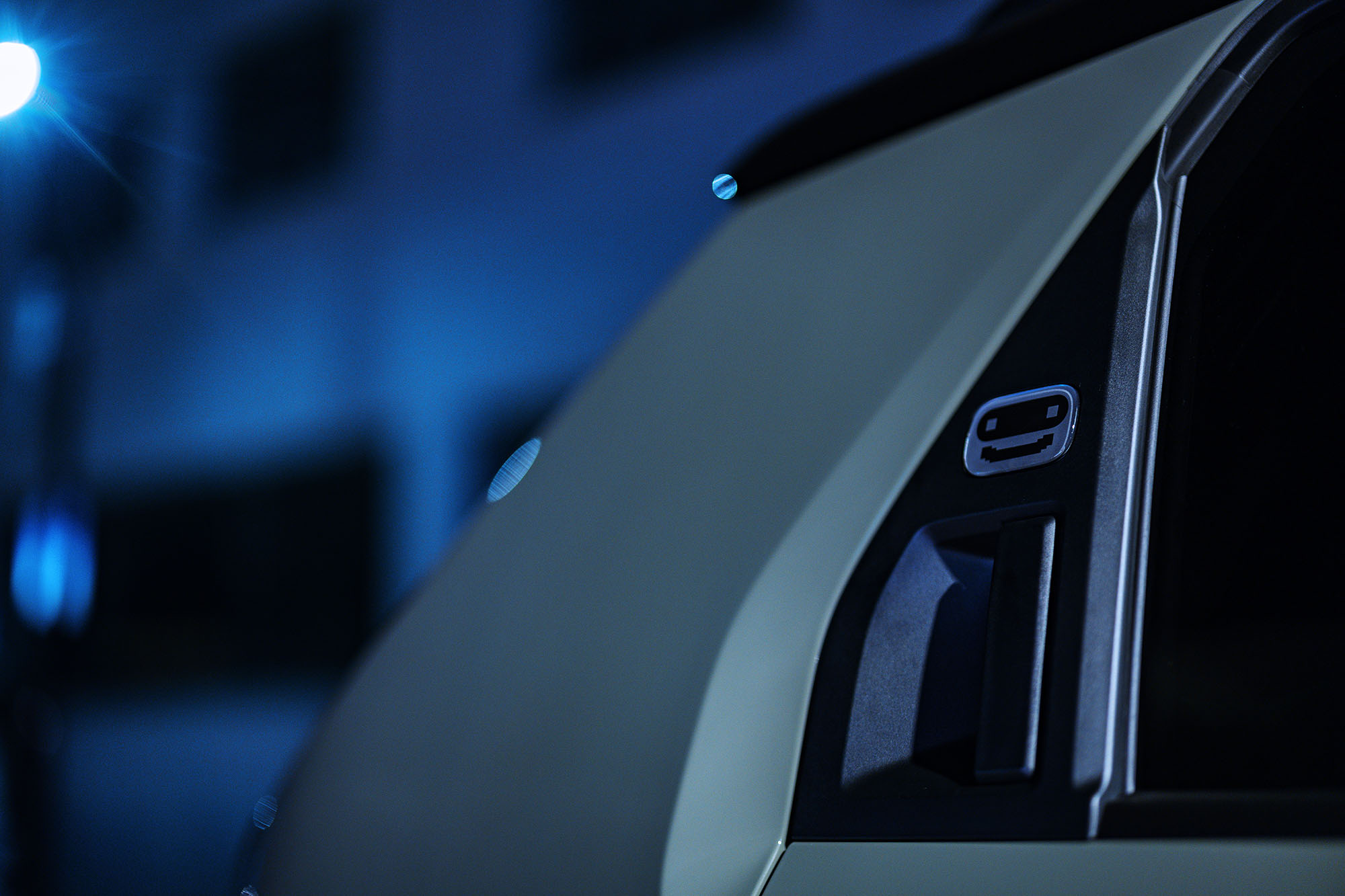
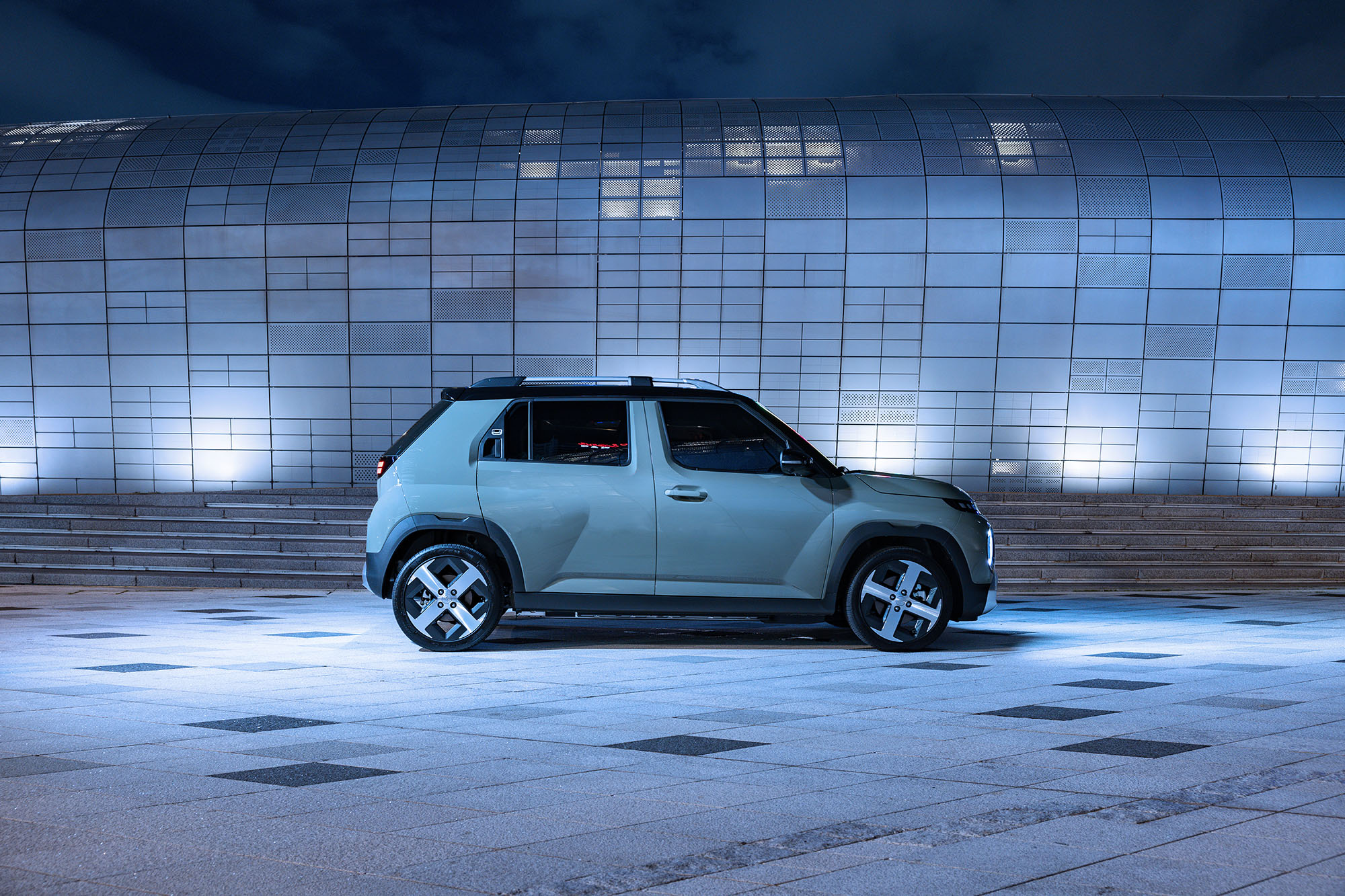
PLAY IF SAFE? NEVER!
Given these credentials, the Hyundai would arguably be a sales success even if it was tedious to look at and to drive. But… well, just look at it. There’s a lot to take in. Those flared plastic-clad wheelarches, the clamshell bonnet, and robust roof bars give it a bit of off-roadery visual bicep, while the peering round front and rear light units add a dash of anthropomorphic character. Tiled front and rear indicators create a strong visual link with Hyundai’s Ioniq range. It’s bold and distinctive, as we’ve come to expect from a company that’s on a serious design roll with the Ioniq 5 and 6, Santa Fe and Kona.
The cabin is even better. It may be the amuse bouche on Hyundai’s electric menu, but the Inster offers its driver and three passengers almost limousine-like levels of lounging room. The front seats work together to create a bench, like a ‘57 Chevvy Bel Air, while the two 50:50-split rear seats individually recline and slide to boost either legroom, or luggage space from 283 to 351 litres; that climbs to 1059 litres with the rear seats folded down. No frunk, though. Flat front and rear floors further enhance real and perceived space, and you can even fold down the front seats for a doze.
There’s so much more good stuff: a compact centre console liberally peppered with buttons, wireless charging, a charging shelf for additional phones, houndstooth fabric, logically structured menus on the central screen, and stowage space wherever you look. I’ll pass on the interchangeable tonka-toy plastics filets on the door cards, though – they’re supposed to be cool and quirky, but for me they’re neither. It’s an interior that works well on all levels – it’s intelligently configured, packed with interesting features and ideas, and it’s genuinely roomy. Sure, it’s built to a budget but it’s also been built with a surplus of imagination and personality.
Tackling Seoul’s traffic crush again – doesn’t this city ever sleep? – gives the Inster a chance to show its urban ability. This is the 95bhp/42kWh-battery version, and it feels way more alert and zippy than its 11.7sec saunter to 62mph suggests. It slingshots away from standstill, slots into fast-moving traffic with ease and generally manages city driving like a boss. Hyundai quotes a 1305kg kerbweight (1335kg for the 49kWh model), and you can really feel the on-the-move agility and responsiveness that sylph-like weight delivers. The adjustable regen set-up is ideal for one-pedal driving, and while the brakes are up to the job, more initial bite would be welcome.
The quick and responsive steering works hand-in-glove with a low centre of gravity and decent body control to make easy work of impromptu lane-changes and some quick last-second slices across four lanes of traffic to take the correct off-ramp exit. Sorry about that, Seoul drivers. Excellent visibility and tiny overhangs further add to the Inster’s urban armoury. I muck about with the drive modes – Sport, Eco, Snow and Normal – and keep it in Sport mode for maximum jauntiness.
The little Hyundai rides with big-car compliance, its front MacPherson strut and rear torsion beam doing a solid job of holding unwanted body movements to account. But while most dips, creases and ridges are taken in its stride, larger intrusions occasionally flummox the suspension. Instead of sponging away the intrusion, it crashes about as if it’s been caught off guard and comes up against its bump stops. Note to Hyundai Europe – nothing a little finessing of the spring and damper rates wouldn’t sort out.
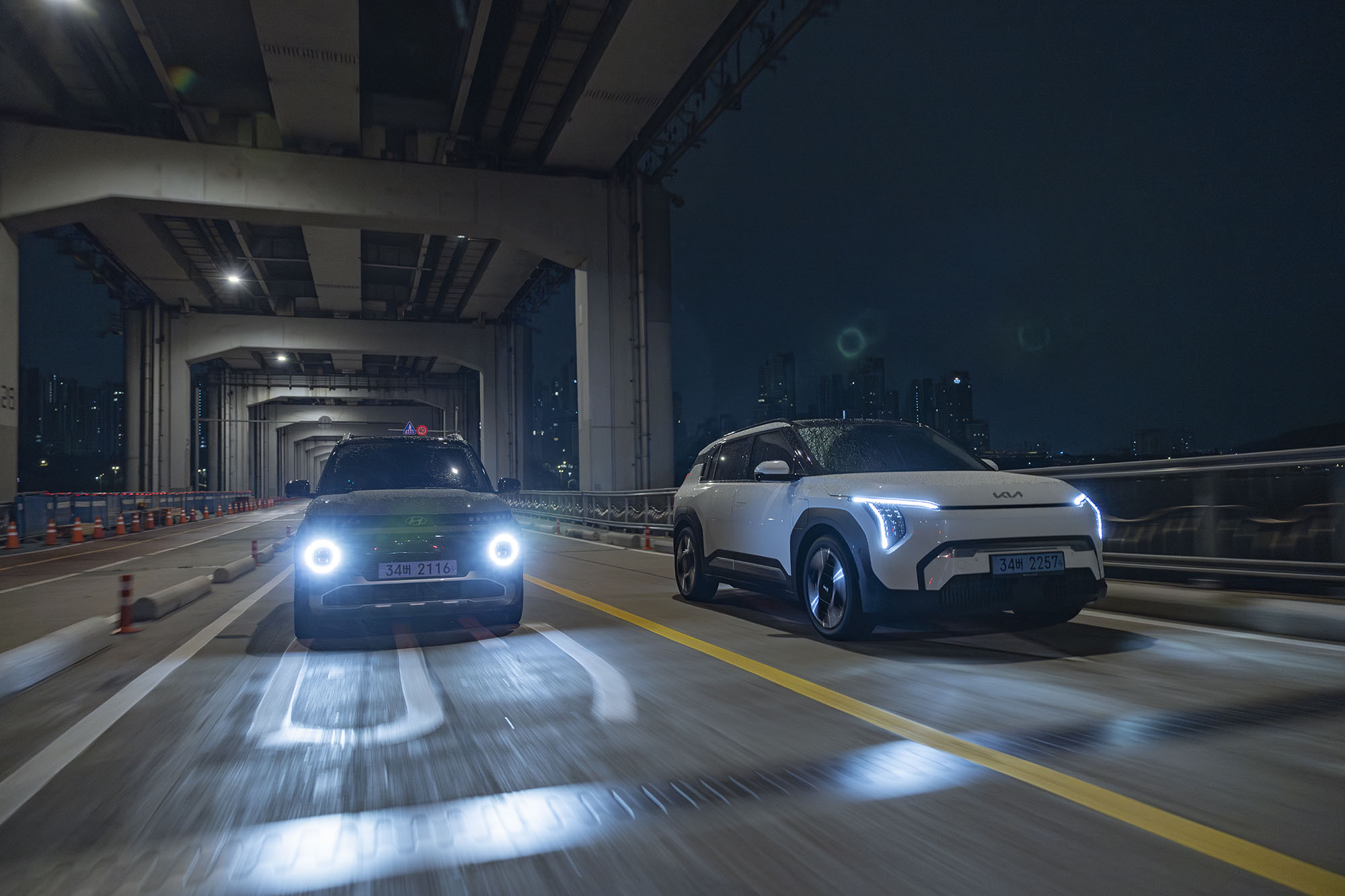
YOU WATCHING, VW? YOU TOO, TESLA?
Sitting and looking at the Inster and EV3, parked late at night, I try to grasp the huge achievement these two critically important cars represent. The Kia blows me away. Distinctive and dynamic design, a spacious and intelligently-configured cabin, brisk performance and an absorbent ride quality, plenty of kit, impressive range and all at a price that’s closer to affordable than most of its rivals.
So impressive on so many levels. This is Kia showing VW how to do a family car properly. It’s the ID. 3 that VW should have delivered from the get-go. And Tesla seems to have backed away from the ‘Model 2’ that would have been in direct competition with these cars. Well, that looks like a very odd decision in light of how good these cars are.
The Hyundai is equally remarkable – it bullseyes the compact urban runabout target with a cool Dikec-like accuracy. A tiny car that’s big where it counts. Big on smart and adaptable packaging, big on personality and allure, and big on range and verve. It heralds the arrival of the accessible electric car with a classiness that’s been sadly absent from other budget EVs.
Many already believe that Korea has dominated the fraught paradigm shift from combustion to electricity over the last five years; the EV3 and the Inster will take that up several notches in 2025 by bringing the same excellence within reach of more buyers.
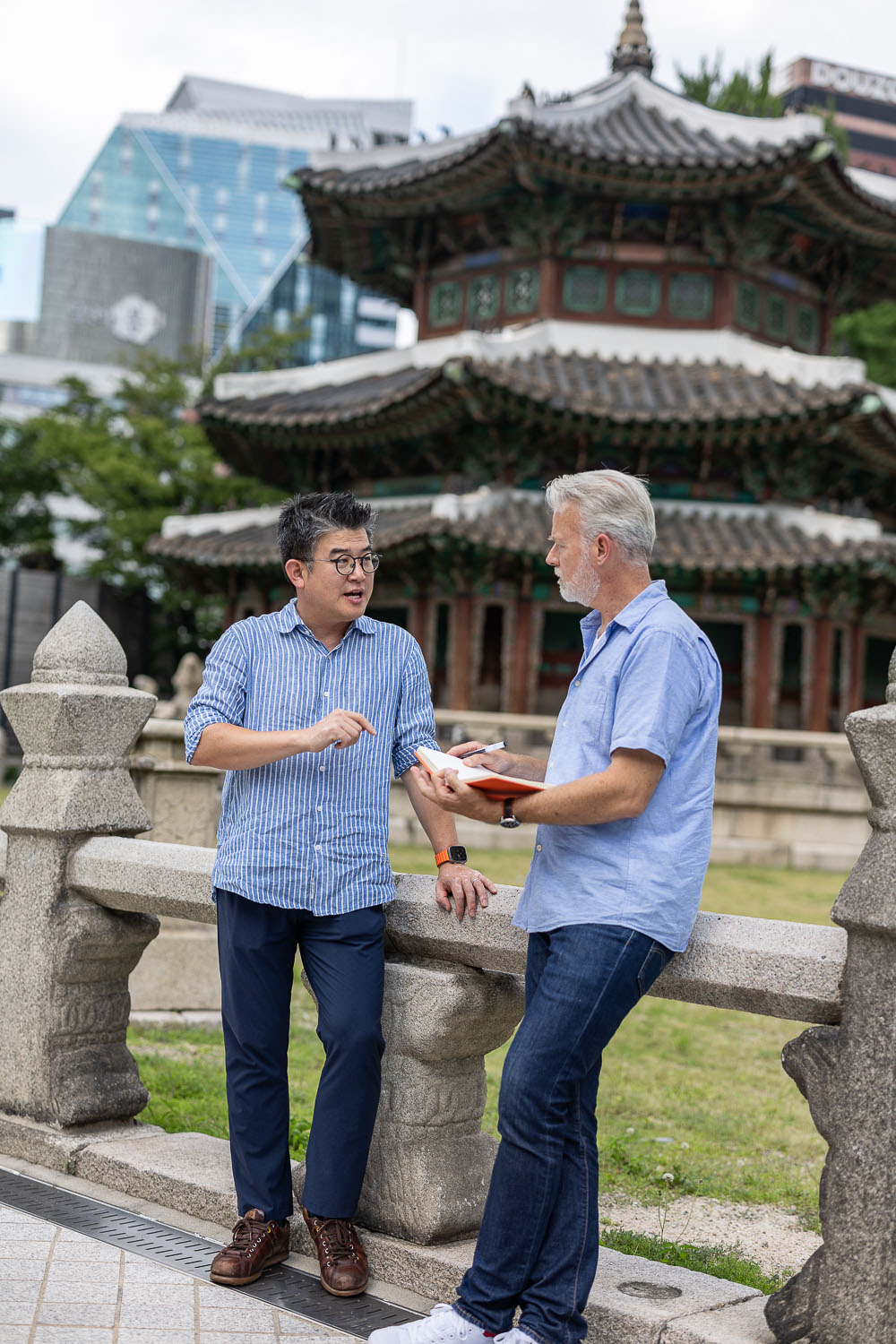
FROM FAMINE TO FEAST
‘To understand where Korea is going, you need to know where it came from,’ says Ki Bong Kwong, one of the country’s leading cultural historical writers. ‘Korea was levelled to the ground during the war, so we rose from its ashes desperate to ensure we never found ourselves in the same situation. This hunger for growth is rooted in real physical hunger. This is why “Did you eat?” is a common greeting here because that painful memory of hunger is still with us. Similarly, our approach to hospitality is underpinned by the saying “Never let the guest go hungry” because we never want to be in a position where we cannot feed anyone again.
‘In the 1980s and 1990s Korea was what we called a “fast follower”. We imitated what other established economies produced but did it better. We played a key role in the East-West détente politics at that time, so when China opened up and absorbed a huge amount of labour-intensive production from Korea, we had to pivot from mimicking to innovation.’ This came to a grinding halt with the 1997 economic crash and humiliating IMF bailout. A full economic restructure led by Kim Dae-jung, the country’s Nobel Peace Prize-winning fifteenth president, saw Korea once again rise up against adversity with a focus on the technology, auto, electronics, and cyberinfrastructure sectors. ‘We have a powerful and complex combination of soft and hard exports – music, cinema and culture, as well as cars, semiconductors and electronic circuitry. Back in the late 1950s and early 1960s, our hunger was for food. Now we have a hunger for absolutely everything.’

